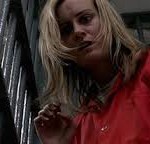by Jenny Coates
Coming up to one year of Reflexive Horizons, we’re making a few changes; in next year’s writing, we’ll be including television and other screen media in line with our affiliation with the School of Oriental and African Studies’ Centre for Film and Screen Studies. But we’re keeping some things the same too, strengthening our focus on philosophical approaches to screen imagery. I’m attempting to kick us off here with some new material and old theory, thinking about the popular appeal of Jenji Kohan’s Orange is the New Black (2013- ) in light of her previous work on Weeds (2005-2012).
While scholarship on Weeds and Orange is the New Black has tended to focus on the shows’ alternative depictions of gender (Snyder 2014), race (Gillota 2012) and criminalized counter cultures (Lavoie 2011), online media has concerned itself with issues closer to the concerns of this blog, focusing particularly on what makes the shows so watchable. Netflix’s original content format makes this an engaging topic, as all thirteen episode of Orange is the New Black are ‘dumped’ on the site on release date, making it perfectly possible to watch straight through the series, work commitments, internet connection and, crucially, interest permitting.
Many viewers, myself included, did almost exactly that (McNamara 2013; Lyons and Weber 2013). (Is that a wise admission so soon after starting a new job? I watched on weekends. Mostly.) So what makes Orange is the New Black so engaging? From ‘highbrow’ to ‘lowbrow’, print and online media has noted the diversity of female representation on the show, and singled out its treatment of gender and sexuality-related issues for widespread praise. Race and class issues in the show’s two-series narrative have been received with slightly more skepticism, as the melting pot of Weeds, which regularly featured mixed race couples and countered many dominant representations of ethnicity on screen, is replaced by the definitive ethnic segregation of prison life as presented in Piper Kerman’s original memoir Orange is the New Black: My Year in a Women’s Prison (2011), on which the show is loosely based.
The recognition factor – can we see a version of ‘ourselves’ onscreen – certainly has

an impact on our appreciation of any given visual text, as does how closely that text chimes with our ideals, values, and our political affiliations, real, imagined or idealized. If we identify as loosely left-leaning humanists (as many hipsterish Netflix viewers do), humanistic representations of minority persons and issues that challenge dominant representative conventions will of course grab our attention. But what keeps us hooked? Miriam Hansen’s work on the intersections of screen media and social change, from which this blog takes its title, argues for cinema in the 1920s and 1930s as ‘the single most inclusive, cultural horizon in which the traumatic effects of modernity were reflected, rejected or disavowed, transmuted or negotiated’ (Hansen 2000: 341-342). The visual media that holds our attention today often does something similar, testing and working out social issues and anxieties on the big or small screen. Like Weeds, Orange is the New Black may represent recognizable realities, but the show also subjects these themes to a series of tests, pushing them one way and then another, before presenting the viewer, not with a resolution, but with greater confusion than there was before. Character arcs pass through sympathetic and beyond into the realms of horror, before curving back into something spookily recognizable. Weeds’ Nancy Botwin developed over the course of eight seasons from a timid suburban mother to a character explicitly recognized by others as borderline psychotic, addicted to danger and sabotage, both of the self and of others. Piper Chapman may have begun Orange is the New Black as another nervous “skinny white lady”, but her journey to the extreme edge of socially acceptable behaviour has been more rapid, ending season one in a violent fury leading to blackout and memory loss.
So how does Kohan maintain our engagement with these characters and those around them who show equally disturbing tendencies? While scholarship and journalism alike have focused on the aspects in which these shows break new ground, online media indicates how Kohan also plays on more familiar affects to keep us hooked. Like many shows with a devoted viewership, Weeds and Orange is the New Black are linked to the world outside the show by the work of journalists and bloggers who connect the viewer to its content as consumers as well as viewers; we can buy the music on the soundtrack or (some of!) the outfits worn by the stars, both on and off-screen. The volume of this media speaks to two aspects of Kohan’s work neglected by academic critique: soundtrack and star persona. In the second part of this article, I’ll consider how soundtrack, star persona and a visual and narrative motif I’ll call banal magic-realism combine to make a highly affective appeal to the viewer.
Breaking our hearts: Kohan’s soundscapes
Both Weeds and Orange is the New Black use music to shape the affective impact of scenes that tread a fine line between comedy, tragedy and horror. Kohan’s music (selected by a variety of people over the long-running shows) is often diegetically- linked even when it is not strictly diegetic; Andrew Bird’s ‘Pulaski at Night’ ,with its refrain of “Chicago, city of light” plays over Piper’s realization that she is being transported to Chicago in the first episode of season two, while Rilo Kiely’s ‘With Arms Outstretched’, playing over the final scenes of the first and last episodes of Weeds, links Nancy’s characterization to themes of struggle, failure, impatience, and her proxy Jewish identity (“Its been sixteen miles/ To the promised land/ And I promise you/ I’m doing the best I can”). Scenes in which characters sing along to diegetic music, such as Lorna Morello’s rendition of ‘Almost Paradise’ along

with the prison van radio, shade from comic to sinister as we line the lyrics up with events in the narrative. Music can also lull us into a false sense of security; ‘Don’t Fear the Reaper’ plays over Rosa’s escape, lightening the mood until she runs down Vee brutally and without regret. Online in fan communities, viewers most often write about and seek out the songs that they say ‘broke my heart’, music that expresses the complex feelings of a taciturn character. But there are some pretty hilarious musical moments as well, usually related to the perfect timing of non-diegetic imagery – the pause between the last outrageous events of episode three of season one of Orange is the New Black (‘Lesbian Request Denied’) and the first lines of Boss’ ‘I Don’t Give a Fuck’, or the pained vowels (“aaaaaaah!”) of Martin Creed’s ‘I Can’t Move’ played over Cecilia Hodes’ incontinence in the third episode of season one of Weeds (‘Good Shit Lollipop’).
Star persona as anti-affect
It may seem strange to be arguing for the affective impact of Kohan’s shows as a reason for their popularity given the non-communicative traits both the central protagonists and many other characters share. From Nancy’s weak efforts at verbalizing affection – she tells her bereaved ten year old, “I am very fond of you” (‘Lude Awakening’, season 1 episode 5), to Piper’s tough prison resolve, Kohan’s characters rarely deliberately articulate truthful emotion. Star persona works both for and against this trait; Mary Louise Parker’s highly emotional performances in previous work such as Fried Green Tomatoes (John Avnet, 1991) and Angels in America (Mike Nichols, 2003) suggest that Nancy’s calm is reigned-in rather than lobotomized, a reading supported by her quickness to anger and knee-jerk violent reactions. Her turn as Amy Gardner in the West Wing (23 episodes, 2001-2006) associated her star persona with quick-witted sarcasm, which Kohan plays on in giving Nancy lines which in other contexts could be read as racist (Dealer: “You calling black people dumb?” Nancy: “And they’re lazy. And they steal”, in season 1, episode 1, ‘You Can’t Miss the Bear’). The feminist tone of these previous noted performances also mediates Nancy’s romantic and sexual exploits throughout Weeds, which often tread grey areas in terms of consent, and moral and ethical choices.
By contrast, Orange is the New Black stars the relatively unknown Taylor Schilling, more famous for being cut out of major films than for being in them (Argo, 2013). The Lucky One (2012), a Zac Efron vehicle, was aimed at a very different audience demographic than Orange is the New Black, which followed the Netflix-commissioned House of Cards (2013- ) and so carried some of the marketing expectations and audience demographics of the earlier series starring ‘high brow’ star Kevin Spacey and directed in part by David Fincher. Netflix’s commissioned titles are building a ‘high brow’ aura closer in many ways to film than TV, as are HBO series such as True Detective (2014- ). In this realm, Schilling was relatively unknown – Kohan has spoken of her as a “trojan horse” in that she is both a way into the stories of the other prisoners and a blank slate of a star persona (Nicholson 2013). Schilling’s unknown status diffuses viewer affective response among the characters rather than having us side with Piper, as we are not encouraged to place our sympathies with Schilling on the basis of previous performances, as we are with Parker. This casting shift is also due to Kohan’s growing auteur persona; from early one-off stints on Sex and the City (1998) and Gilmore Girls (2000), Kohan’s signature brand of unhinged lady protagonist has become too recognizable to allow for a repeat of the shock factor of our slow realization that Weeds’ Nancy was very much Parker playing against type. In Orange is the New Black, the technique is reversed to present an unknown star/protagonist whose self-interest paradoxically leads the camera into the lives of other characters.
Banal magic-realism as character-audience bonding
Difficult, unemotional protagonists are made accessible to the viewer in Weeds and Orange is the New Black using soundtrack and star persona, but also by a narrative motif I’ll call a sort of banal magic-realism. Magic realism, or ‘when a highly detailed, realistic setting is invaded by something too strange to believe’ (Strecher 1999: 267) is used in literature and film to interpret or express everyday events or feelings too complex to put into words, for example, in Pan’s Labyrinth (El laborinto de fauno, Guilermo del Toro, 2006) where
is the New Black using soundtrack and star persona, but also by a narrative motif I’ll call a sort of banal magic-realism. Magic realism, or ‘when a highly detailed, realistic setting is invaded by something too strange to believe’ (Strecher 1999: 267) is used in literature and film to interpret or express everyday events or feelings too complex to put into words, for example, in Pan’s Labyrinth (El laborinto de fauno, Guilermo del Toro, 2006) where

the child protagonist both escapes and comes to understand Franco’s Spain by communing with a magical world in which fascist persuasive tropes are allegorized through fairy-tale. In both Weeds and Orange is the New Black, characters make wild claims about the existence of things, usually animals, in the everyday world, which the central protagonist dismisses as fantasy. These dismissals, such as Nancy’s disbelief at her son’s claim to have shot a mountain lion (season 1 episode 3, ‘Good Shit Lollipop’) or Piper’s refusal to believe that cockroaches can be trained to smuggle cigarettes (season 2 episode 1, ‘Thirsty Bird’), initially posit the protagonist, usually in a period of emotional turmoil, as the sanest of a group of delusionals. However, a later shot in which the protagonist, alone, confirms visual evidence of the claim, suggests to the viewer either that the world is more magical, in a banal sense, than we have believed, or that the protagonist is losing her grip on reality. As the viewer is always the only other witness to these encounters with the banal-magical, either interpretation (or both) creates the feeling of a shared secret or experience, and adds an element of the magical to our relationship with the protagonist, strengthening our investment in their story.
Selling anti-heroines
While popular media and scholarly approaches alike have championed Kohan’s protagonists as anti-heroines changing the limits of acceptable female representation on screen, there hasn’t been much discussion of how these representations are made acceptable, or enjoyable to watch. Weeds ran for eight seasons, and Orange is the New Black has already been commissioned for a third, so we have to ask, how does Kohan sell these challenging female characters so successfully and to such wide audiences? I’ve tried to draw out a few elements which run continually throughout both series to examine how these difficult characters are made appealing to viewers at a highly affective level using sound, star persona and narrative motifs.
Works cited:
Bullock, Darcey. ‘8 Ways ‘Orange is the New Black’ is Breaking TV Barriers.’ Mic, 1 August 2003. Available at http://mic.com/articles/57611/8-ways-orange-is-the-new-black-is-breaking-tv-barriers
Gabrielson, Teena. ‘The End of New Beginnings: Nature and the American Dream in The Sopranos, Weeds, and Lost,’ Theory & Event 12: 2, 2009.
Gillota, David. ‘”People of Colors”: Multi-ethnic humor in Harold and Kumar Go to White Castle and Weeds.‘ The Journal of Popular Culture, vol. 45 pp. 960-978, 2012.
Hansen, Miriam Bratu. ‘The mass production of the senses: classical cinema as vernacular modernism.’ In Christine Gledhill and Linda Williams (eds.), Reinventing Film Studies, London: Arnold, 2000, pp. 332-350.
Hernandez, Brian. ‘Oh, Memories: 25 Songs Used in ‘Orange is the New Black.’ Mashable, June 2014. Available at http://mashable.com/2014/06/13/songs-orange-is-the-new-black-season-2-music-soundtrack
Lavoie, Dusty. ‘Smoking the Other: Marijuana and Counterhegemony in Weeds.’ Substance Use & Misuse, vol. 46, pp. 910–921, 2011.
Lyons, Margaret and Lindsey Weber. ‘So, Is Orange Is the New Black’s Opening Song Catchy or Annoying?’ 2013 http://www.vulture.com/2013/07/orange-is-the-new-black-theme-song-regina-spektor-debate.html
MacNamara, Mary. “Review: Lock yourself up with ‘Orange Is the New Black.'” Los Angeles Times. 10 July 2013.
Michlin, Monica. ‘More, More, More.’ Mise au point vol. 3, March 2011. Available at: http://map.revues.org/927
Nicholson, Rebecca. ‘Orange is the New Black: Web Tv’s breakout moment.’ The Guardian, September 2013. Available at http://www.theguardian.com/tv-and-radio/2013/sep/11/orange-is-the-new-black-web-tv-breakout
Paige, Alexis. ‘Seeing Orange.’ Fourth Genre: Explorations in Nonfiction vol. 16 issue 1, pp. 143-151, 2014.
Robinson, Joanna. ‘Orange is the New Black: What Was that Great Song from the Premiere?’ Vanity Fair, June 2014. Available at: http://www.vanityfair.com/vf-hollywood/orange-is-the-new-black-premiere-song
Snyder, Katie. ‘Burn one down: Nancy Botwin as (post) feminist (anti) heroine.’ In Norma Jones, Maya Bajac-Carter and Bob Batchelor (ed.) Heroines of Film and Television: Portrayals in Popular Culture. Plymouth: Rowan and Littlefield, pp. 17-30, 2014.
Strecher, Matthew C. ‘Magical Realism and the Search for Identity in the Fiction of Murakami Haruki.’ Journal of Japanese Studies, vol. 25 no. 2, pp. 263-298, 1999.
Zuckerman, Esther. ‘The Best Musical Moments from ‘Orange Is the New Black’ Season 2,’ June 2014 http://www.thewire.com/entertainment/2014/06/the-best-musical-moments-from-this-season-of-orange-is-the-new-black/372491/
Jennifer Coates

Jenny has just been awarded her PhD from the School of Oriental and African Studies in London for a thesis on “National Crisis and the Female Image; Expressions of Trauma in Japanese Film 1945-1964.” She is now based at the Hakubi Centre for Advanced Research at the University of Kyoto. Her research interests include gender, visual media and memory studies. She’s often up all night, so forgive her the odd typo.